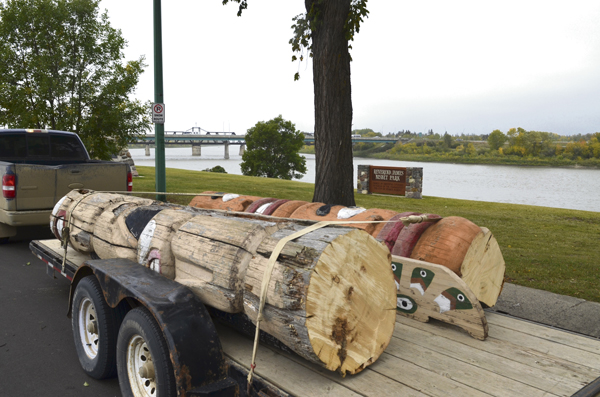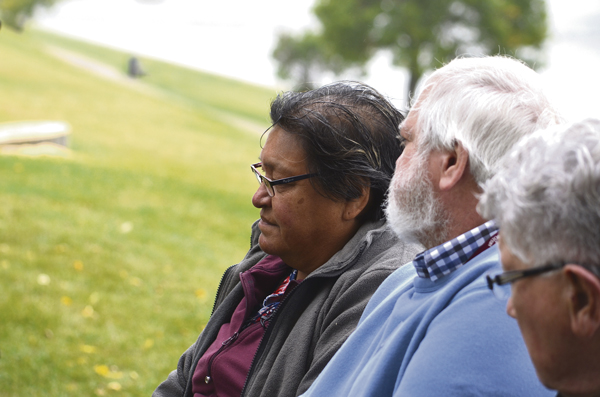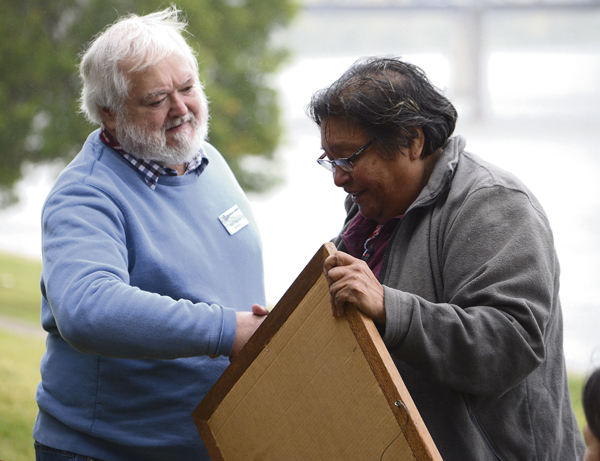
The totem pole that had overlooked the North Saskatchewan River in Prince Albert for the last 44 years came down Monday.
The city held a ceremony to recount the history of the totem pole and to say goodbye to the icon, which had been carved as a gift by Saskatchewan Penitentiary inmates in 1975.
City officials, students, and the family of one of the original carvers gathered nearby the stump of the removed pole to reflect on its meaning.
“This is a very auspicious day,” Deputy Mayor Don Cody said.
“It’s a day that all of the city’s … residents will remember forever. We go with heavy hearts today when we see that one of our great pieces of art is leaving us. However, it is leaving and will be put to rest in a very well-deserved place. For that, we appreciate it.”
The totem pole will now travel to Okanese First Nation in southern Saskatchewan, near Balcarres. That’s where Dale Stonechild, the primary assistant to the main carver, James Sutherland, hails from.
The pole had to come down as it had begun to rot and was considered a safety risk.

The city had consulted with knowledge keepers as to the proper protocol. They attempted to contact the original artist, but Sutherland had died and the city couldn’t track down his next of kin.
They learned that in the tradition of coastal BC peoples who carve totem poles, the poles are allowed to fall and return to the earth, or else they are removed and laid to rest.
That was the plan for Prince Albert’s totem pole, until Dale Stonechild’s sister, Darlene, contacted the city and offered to bring the artifact to her home.
Monday morning, the pole was dismantled and loaded onto a trailer. Darlene said she plans to restore the totem pole so Dale’s family can see what he created during his stay in the penitentiary. She thanked the city for allowing her to take home a part of history her brother helped to build.
Once it’s restored, Darlene said she’ll have a pipe ceremony and a feast to honour the tree itself, Sutherland, her brother and the other inmates who helped build the pole and the people from Prince Albert.
“We’ll rebuild it the proper way and do the protocol,” she said.
Darlene said her brother supports the plan. She spoke to him by phone on Monday morning. He’s currently serving a sentence at a federal institution in BC.
‘We don’t have a flag … so that totem pole is our flag. That’s what my brother told me,” she said.
“We honour that.”
While the pole has been removed, the Prince Albert Historical Society has vowed that its history would not be forgotten.
Historical society member Fred Payton was a staff member at the Saskatchewan Penitentiary when the totem pole project was approved. He said it came at a time where federal corrections were moving from a philosophy of punishment to one of rehabilitation.
“I’m not sure the term art installation had been coined by 1975, but that was basically the idea that James Sutherland and Dale Stonechild came up with,” he said.
“Sutherland’s grandfather had taught him at the age of 11 how to carve. Stonechild was, and still is, a consummate fantastic artist.”
The inmates chose to carve the story of the eagle and the beaver, where the eagle teaches the beaver how to exist in the world in which he finds himself, while the beaver passes along what he’s learned to the eagle.

“It is interesting to me how the allegory parallels what was happening at that time in correctional programming,” Payton said.
“The citizens of Prince Albert were trying to teach those people in the penitentiary how they could function successfully in the world to which they would ultimately be released.”
Payton praised the insight of then-warden, Jim O’Sullivan, who agreed to the proposal despite security concerns and the difficulty of finding an appropriate log.
The final product stood 34 feet high and was three feet around. Its presentation to the city included a ceremony with First Nations dancers who told the same story presented on the totem pole.
“This gift to the citizens of Prince Albert has stood proudly on the riverbank, welcoming visitors to our city and reminding each of us of the importance of paying it forward,” Payton said.
“The Prince Albert historical society will not allow its memory and the story it tells to be forgotten.”
Payton turned to Darlene, holding a framed, hand-written story.

“James and Dale … gave us this story of the Eaglechild pole. You’re taking it home to Dale’s home community and we give you this story to take with you.”
For Darlene, the moment was “emotional.
“I’m sad that it’s come down, but I’m also happy that I’m taking it home to my grandchildren. His grandchildren and his family will appreciate it, she said.
“(Dale) is okay with it. He’s happy that it’s going to be shown to his family. I’ll have a piece of him every morning in my yard.”

